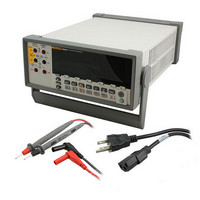8808A 120V Fluke Electronics, 8808A 120V Datasheet - Page 67

8808A 120V
Manufacturer Part Number
8808A 120V
Description
DMM 5.5 RES RS-232 INTERFACE
Manufacturer
Fluke Electronics
Type
Digital (DMM)r
Specifications of 8808A 120V
Includes
Test Leads
Style
Bench
Display Digits
5.5
Display Type
VFD, Dual
Display Count
200000
Function
Voltage, Current, Resistance, Frequency
Functions, Extra
Continuity, dB, Diode Test
Features
Hold, Min/Max, RS-232 Port
Ranging
Auto/Manual
Response
True RMS
Lead Free Status / RoHS Status
Not applicable / RoHS non-compliant
Other names
614-1068
If Test Fails
How the Meter Processes Input
Input Strings
Input Terminators
If the Meter does not respond as indicated in the “Installation Test for RS-232 Operation”
section, perform the following:
The following sections describe how the Meter processes input received from a host or
stand-alone terminal.
The Meter processes and executes valid input strings sent by the host. A valid input string
is one or more syntactically correct commands followed by an input terminator.
When the Meter receives input, it stores it in a 50-byte input buffer.
The Meter accepts alphabetic characters in uppercase and lowercase. If a command
cannot be understood, the command and the rest of the command line are ignored.
When the Meter receives an input terminator, it executes commands on a first-in first-out
basis as entered since the last terminator was received.
As input characters are processed and executed, space is made available in the input
buffer for new characters. In RS-232 applications, if a communication error (parity,
framing, overrun) is detected, a device-dependent error is generated and the input string
is discarded. If the Meter's input buffer becomes full when it is used with the RS-232
interface, a device-dependent error is generated (see “Event Status and Event Status
Enable Register”) and the input string is discarded.
Valid terminators for the RS-232 interface are:
In this Chapter, “input” means a string sent to the Meter from a host, and
“output” means a string sent to the host from the Meter through the
computer interface.
Input strings received over the RS-232 interface are not executed or
checked for proper syntax until an input terminator is received or the input
buffer becomes full.
6. If the Meter does not respond as indicated, refer to the “If Test Fails” section.
1. Ensure all cables are properly connected. See the “Cabling the Meter to a Host or
2. Ensure that the communication parameters (baud rate, parity, etc.) on the Meter
Printer (RS-232)” section earlier in this chapter.
and host are identical. See the “Setting Communication Parameters (RS-232)”
section earlier in this chapter.
CR (Carriage Return)
LF (Line Feed
CR LF (Carriage Return/ Line Feed)
Note
Note
Operating the Meter Using the Computer Interface
How the Meter Processes Input
4
4-7










